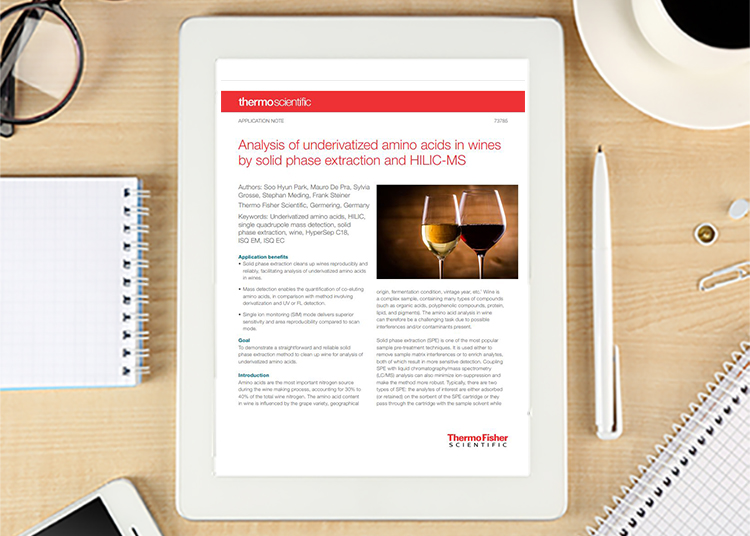Application Note: Analysis of underivatized amino acids in wines by solid phase extraction and HILIC-MS
- Like
- Digg
- Del
- Tumblr
- VKontakte
- Buffer
- Love This
- Odnoklassniki
- Meneame
- Blogger
- Amazon
- Yahoo Mail
- Gmail
- AOL
- Newsvine
- HackerNews
- Evernote
- MySpace
- Mail.ru
- Viadeo
- Line
- Comments
- Yummly
- SMS
- Viber
- Telegram
- Subscribe
- Skype
- Facebook Messenger
- Kakao
- LiveJournal
- Yammer
- Edgar
- Fintel
- Mix
- Instapaper
- Copy Link
Posted: 6 August 2021 | Thermo Fisher Scientific | No comments yet
Goal: To demonstrate a straightforward and reliable solid phase extraction method to clean up wine for analysis of underivatized amino acids.
Amino acids are the most important nitrogen source during the wine making process, accounting for 30% to 40% of the total wine nitrogen. The amino acid content in wine is influenced by the grape variety, geographical origin, fermentation condition, vintage year, etc.1 Wine is a complex sample, containing many types of compounds (such as organic acids, polyphenolic compounds, protein, lipid, and pigments). The amino acid analysis in wine can therefore be a challenging task due to possible interferences and/or contaminants present.
Solid phase extraction (SPE) is one of the most popular sample pre-treatment techniques. It is used either to remove sample matrix interferences or to enrich analytes, both of which result in more sensitive detection. Coupling SPE with liquid chromatography/mass spectrometry (LC/MS) analysis can also minimize ion-suppression and make the method more robust. Typically, there are two types of SPE: the analytes of interest are either adsorbed (or retained) on the sorbent of the SPE cartridge or they pass through the cartridge with the sample solvent while undesired compounds or contaminants are retained on the sorbent.2 For example, nine catechins and phenolic acids in a red wine were extracted by the former SPE method using Thermo Scientific™ HyperSep™ Retain PEP (polar enhanced polymer) material, prior to high performance liquid chromatography (HPLC) analysis.3 The latter SPE method has been widely applied to remove interfering matrix compounds (such as pigments, lipids, and proteins) in chromatographic analysis of polar analytes (such as amino acids, organic acids, and polyphenols) in wines. Briefly, the polar analytes are filtered and passed through C18 SPE cartridges while hydrophobic wine components are retained on the SPE cartridges.2,4
Related content from this organisation
Related topics
Beverages, Contaminants, Food Safety, Ingredients, Lab techniques









